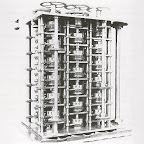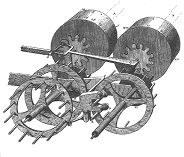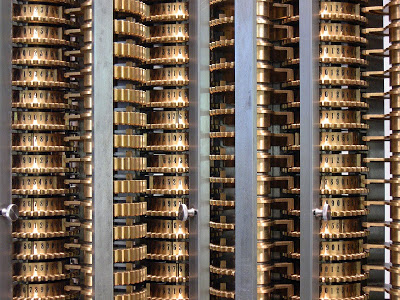Babbage analytical machine. Part two - the tragic fate of computer technology of the XIX century

The first part of the article can be found at this link .
The idea of the difference machine was visited by Charles Babbage either in 1812 or in 1813. A more accurate date history hides from us. What was supposed to do the conceived car?
In order to understand this - you have to remember a little math.
')
As we remember from the previous article, the machine was designed for tabulation, that is, the calculation of mathematical tables.
A bit of theory
Suppose it is necessary to tabulate the function N = n ^ 4 (n = 1,2 ...).
Consider the table below:
| Argument (n) | Value (R1) | Difference # 1 (R2) | Difference # 2 (R3) | Difference №3 (R4) | Difference №4 (R5) |
| one | one | 15 | 50 | 60 | 24 |
| 2 | sixteen | 65 | 110 | 84 | 24 |
| 3 | 81 | 175 | 194 | 108 | 24 |
| four | 256 | 369 | 302 | 132 | 24 |
| five | 625 | 571 | 434 | 156 | 24 |
| 6 | 1296 | 1105 | 590 | 180 | |
| 7 | 2401 | 1695 | 770 | ||
| eight | 4096 | 2465 | |||
| 9 | 6561 |
The first column is the function argument, the second is the function value for the given argument. The third column is the difference between the subsequent values of the function and the previous ones. That is, line number 1 = 16 - 1, line number 2 = 81-16, and so on. We do the same thing several times (columns "Difference №2", "Difference №3"). It is easy to see that the fourth difference we have completely coincided. And this is no accident - if the function is a nth degree polynomial, then in the table with a constant step (in our example, the step is equal to one) its n-th differences are constant. This little trick gives us one advantage - to find the subsequent value of a function, it is necessary to add up all the differences to the fourth with the current value of the function.
For example, 9 ^ 4 = 4096 + 1695 + 590 + 156 + 24 = 6561 (who does not believe, can use the calculator).
Babbage assumed to calculate functions with constant sixth differences. To do this, the machine had to have seven registers - by register for each difference and one for the result, and the result should have been the result of seven additions. A very time-consuming option, and Babbage came up with a way to optimize it. He proposed to write odd-order differences from the previous line, then the next value of the function can be calculated in two steps, first calculating the odd differences in parallel and then even the value of the function.
For example, we count for N = 8 at the first stage R2 = 1105 + 590 = 1695, R4 = 132 + 24 = 156, at the second stage R1 = 2401 + 1695 = 4096, R3 = 434 + 156 = 590. (If you mess up, I advise you to fill in the spreadsheet and highlight in pairs the corresponding cells, looking at their sum). Already in the 19th century, people tried to optimize calculations — and nowadays it’s worth taking an example from them!

(The mechanism for transferring dozens in Pascal’s machine, the source is Around the World )
Each register was a set of eighteen decimal counting wheels, similar to those of Pascal’s car. The calculation took place in two stages - the first stage is the addition without transfer, the second stage is the addition with transfer from the low-order to the senior (sequential transfer). Such a transfer scheme requires the sequential addition of all digits, taking into account the transfer that could occur on the previous cell. This is the simplest, but the most inefficient transfer scheme, and she did not work with Babbage. Later, working on an analytical machine, he developed a scheme for end-to-end transfer.
For tabulating logarithmic, trigonometric, and other functions, the table was supposed to be divided into sections, each of which was approached by its polynomial. Moving from one section to another, the operator had to manually change the difference values. The car was equipped with a bell that rang after performing a certain number of steps. Also, the differential machine was equipped with a printing mechanism that captured the result on a copper plate. Such a plate could be used for an unlimited number of prints, while eliminating the possibility of introducing an error by the typesetter.
It is worth noting that the idea of a difference machine was expressed as early as 1786 by Johann Gelfreich Muller, but he did not even start building it, and most likely Babbage did not know anything about this idea.
Beginning of work
By the embodiment of the machine in metal and wood, Babbage began in 1820. In 1822 he completed the creation of a small differential machine. She was able to calculate functions with constant second differences up to the eighth digit.

(Counting wheels of the Babbage differential machine. Source wikipedia )
Babbage begins to popularize in every possible way the idea of calculating tables with the help of machines. In 1823, he received funding from the government in the amount of 1,500 pounds and began work on a machine that could tabulate functions with constant sixth differences to the twentieth decimal place. However, by 1828, the allocated funds completely disappear, as well as funds allocated from their own revenues. In the future, financing and construction of the machine continues with varying success, but by the beginning of 1833, it is possible to finish and test a part of the machine that can be tabulated with accuracy to the fifth digit polynomials with constant second differences.
The year 1833 was also a landmark one, since this year the construction of a special fire-protected building for the car was completed, as they would say now, the data center. Moving to a new building caused a pause in the creation of the car. On the one hand, this created new problems - the chief engineer who worked on the creation of the machine, demanded that I pay for the workers. The request was rejected, and he immediately dismissed all the workers and took away all the tools and equipment created during the work on the machine, which fully complied with the English laws of the time.
However, the forced pause led to the fact that Babbage came up with the idea of creating a machine that could calculate not only tables, but would also solve all the variety of problems faced by engineers and mathematicians. In 1834, Babbage develops the basic principles of the new machine, which he calls analytical. However, we will talk about it in the next part of the article.
How are things going with the difference machine? The year 1834 is an article by Dr. Dionysius Lardner “Babbage's Computing Machine”, in which the principle and structure of the machine is described in great detail. This article prompted two Swedes - George and Edward Schütz (father and son) to create their own car.
Tragic finale
Another problem awaits our hero - in 1842, the government refuses to finance the construction of a differential machine, since future costs are much greater than the originally estimated budget.
In the forties, Babbage unsuccessfully trying to obtain funding for the completion of the machine, which he had by then improved noticeably by working on the ideas of the analytical machine.
At the same time, the Swedes successfully continue to work on their version of the differential machine, and by 1854 successfully complete its creation. The demonstration of the car took place at the world exhibition in Paris in 1855, and Babbage in every way welcomed this demonstration. His son Henry has prepared posters explaining the operation of the machine.
During his lifetime, Babbage could not bring his child to the end. The finished part of the car was sent to the Royal College Museum, and in 1862 it was unsuccessfully exhibited at the international exhibition in London, where she was given a small walk-through room, from where she returned to the museum. This time it was a science museum in South Kensington, since the Royal College Museum refused to accept the car.

(Working Difference Machine at the Computer History Museum in Mountain View, California. Source wikipedia )
It is not ironic, but, in spite of the refusal of Babbage, in 1858, the government orders a copy of the Swedish differential machine from an English engineer. This copy was later widely used to calculate the mortality tables for which insurance companies made their accruals.
Despite the death of Charles Babbage in 1871, his ideas continued to live and were embodied in difference machines by various engineers on different continents of the planet.
Working on the differential machine, Babbage came to the idea of a universal machine that could solve a whole range of mathematical and engineering problems. His idea turned out to be so original and ahead of its time, that its realization in a conceived form was embodied much later than the life of its author. This machine, as well as the first programmer, after whom the language of Hell was named, will be discussed in the next part of the article.
The continuation of the article can be found here .
Source: https://habr.com/ru/post/80729/
All Articles